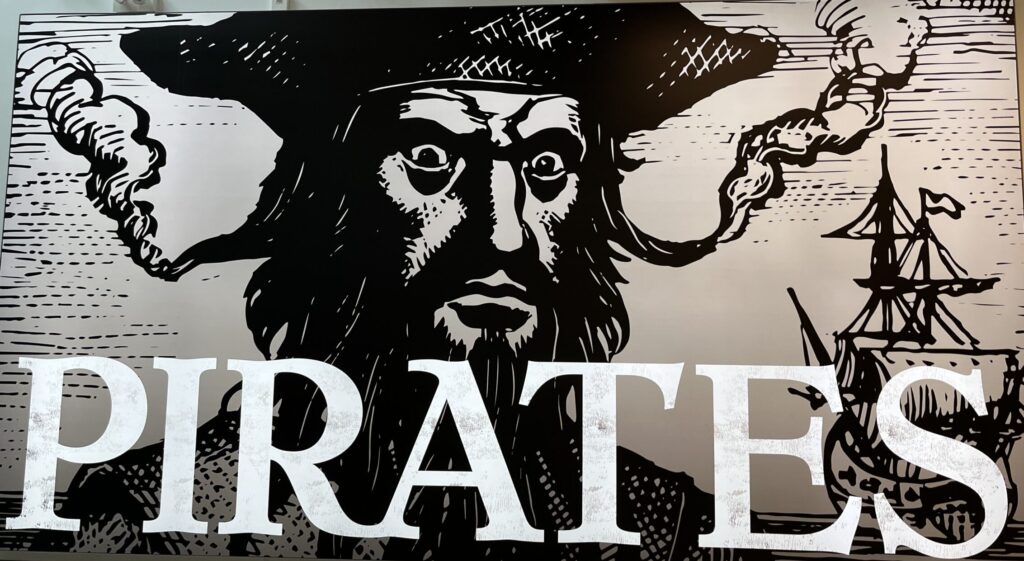Pirates at the National Maritime Museum in Greenwich London demystifies the image of piracy by uncovering many layers that the term pirate has undergone through history, literature and popular culture. I am a massive fan of anything pirate or nautical related, so I was very eager to visit this exhibition. I must admit as a visitor I probably have more knowledge about the subject than the exhibition’s target audience, but I really enjoyed the various angles from the origins of Pirates in literature and stage to the real life people. The exhibition attempts to dissect why society is still so fascinated with the image and history of a pirate despite the bloody and gruesome criminals they were believe to be. Personally, I am fascinated by pirates through the romanised notion of freedom on the open water away from the class politics of land and democracy that many pirates and ships lived under. It’s interesting to understand why many became pirates from necessity from the poor living and working conditions to those trained in the navy that wanted a life away from the strict rules and regulations under employment.

Review
From the start, visitors are greeted with a model of the Flying Dutchman that many will recognise from the Pirates of the Caribbean franchise and first features in Dead Man’s Chest where Davy Jones is first introduced in all his tentacle glory. The exhibition begins with detailing the initial use of pirates in literature with Treasure Island by Robert Louis Stevenson and the story of Jim Hawkins. The exhibition uses a lot different storytelling elements from projections and a narrative recounting the plot of Treasure Island that a large map with projections that visually displayed the story. This form of storytelling was very engaging and wasn’t too fact heavy making the information easily digestible. Secondly, the inclusion of film and theatre posters depicting how pirates have been a popular theme for the daring battles, action and clothing helped give a bigger picture to how history and real life events are often a source of inspiration for fiction. The exhibition also housed several costumes, one that I wasn’t expecting was Orlando Bloom’s Will Turner costumed featured in Pirates of the Caribbean: Curse of the Black Pearl. This being one of my favourite films from my childhood I was very interested in seeing this person.
As the visitor moves around the space there is a deeper look at the historical pirate from the daily routine, the flags and even weapons. There are a variety of historical documents and artefacts that compare real life pirates and the popular culture image. I found it particularly interesting how this has influenced fashion and the exhibition displayed high end fashion brands in Pirate Couture. The exhibition was also child friendly with fact or fiction questions dotted around the space which was a fun addition. As the visitor moves around the space, the context becomes a lot darker moving away from the light-hearted and almost sanitised version of pirates created through popular culture and reveals the darker history of piracy. The space focuses on real life pirates such as Blackbeard who I was very surprised to learn that to keep his gruesome and fearsome image he would pack his beard with slow releasing fuses to spark and fire. Importantly, the exhibition looks at piracy in a global way. The history of pirates wasn’t just Eurocentric, but moved across Asia with focus on female pirate Zheng Yi Sao in the eighteenth century. She was an extremely successful pirate and commanded a large fleet leading her to never being caught or defeated. In 1810 she negotiated with the Chinese Government to be pardoned from piracy. This case study offered at different side to the history of piracy that focused on the not every story was a gruesome death at the gallows or at sea. But a story of power and how this shifted defending on who controlled the seas. The story of piracy in Asia was told through paintings that demonstrated the violence and damage war against pirates underwent with paintings depicting fleets set ablaze and listing the casualties on both sides. In contrary to the story of Zheng Ti Sao, the exhibition moves towards crime and punishment with a haunting image of a replica cage. In this cage pirates convicted for their crimes were hung and covered in tar to be pecked by birds until their death. This cage was hung on its own with a grey background and the cawing of birds that echoes the risks and the end that many pirates suffered.
Finally, the exhibition traced piracy to the modern world and what it means to be called a pirate now. The term pirate is used politically and the exhibition cited a Greenpeace protest in 2013 where 30 people were arrested and accused of piracy while not necessarily undertaking what many may see as ‘traditional’ pirate actions like plundering etc. A map also tracked the growing number of pirates in places such as Somalia and their weapons of choice highlight the growing concern in these areas. A modern day pirate isn’t just large ships with black sails that dominate the sea like in Pirates of the Caribbean but are almost just as much or more dangerous. The swashbuckling image of a pirate that has a parrot on their shoulder and chases buried treasure around the globe has changed to one that is very modern.
Overall, I enjoyed the exhibition and despite already entering the space with a fair amount of knowledge about pirates I learnt a lot about the origins of pirates in literature to screen to the dark history of Asia. I think this exhibition gives a broad look at how pirates have evolved and morphed into different stereotypes and continue to influence and fascinate the public. There are a variety of elements that engage the visitor from visual diagrams and videos to books, film posters, costumes and historical artefacts and replicas. The information is easy to digest and follows a cohesive path between the themes. Pirates is an engaging and thought-provoking exhibition that not only tracks to dark history of the real people, but the popular sanitised version that romanticises the freedom of the open sea away from rules and hierarchy that land offers.
Stay updated
Amy is a writer and reviewer and is currently working on a YA fantasy novel. For more content click here to read book reviews, short stories and updates on Amy’s writing journey.
Don’t forget to follow Amy on TikTok, X and Instagram.

Sign up to Amy's newsletter for exclusive content, updates and reviews!

